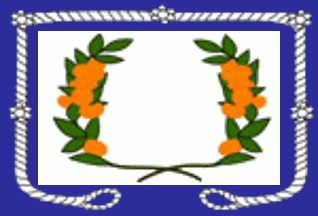 image by Dirk Schönberger,
14 December 2012
image by Dirk Schönberger,
14 December 2012Based on: http://www.narandiba.sp.gov.br/site/simbolos_oficiais.php

Last modified: 2012-12-29 by ian macdonald
Keywords: sao paulo | narandiba |
Links: FOTW homepage |
search |
disclaimer and copyright |
write us |
mirrors
 image by Dirk Schönberger,
14 December 2012
image by Dirk Schönberger,
14 December 2012
Based on:
http://www.narandiba.sp.gov.br/site/simbolos_oficiais.php
A white flag with broad blue border bearing a rope, looped at both ends, and with five knots in it, and on the white rectangle in the centre two branches of orange tree, bearing fruit.
Official website at
http://www.narandiba.sp.gov.br. The
flag is a banner of arms. The version on the site shows a more simplified
version than my version, found on the old CNM site at
http://portal.cnm.org.br/sites/7800/7818/turismoSP/narandiba/BANDEIRA_NARANDIBA_SP.jpg
Dirk Schönberger,
13 December 2012
Narandiba was founded on 18 September 1933 by José Ruiz Peres; the settlement. Originally named Celeste, as a a tribute to Celeste Vendramini, who had offered the land, the settlement was also known as Patrimônio São Francisco de Paula and was subsequently renamed Corruta and Quarenta - being located 40 km of Presidente Prudente. The district of Narandiba was established on 30 November 1944 by State Decree-Law No. 14,334. The district was formed by parts of the districts of Anhumas and Pirapozinho, which belonged to the municipality of Presidente Prudente. The district of Narandiba was transferred to the municipality of Pirapozinho by State Law no. 233 of 24 December 1948. The municipality of Narandiba was established on 28 February 1964 by State Law no. 8,092. and inaugurated on 31 March 1965.
The flag of Narandiba is a banner of the municipal arms (mural crown, supporters and scroll excluded). The flag is white with two branches of orange tree proper and a blue border charged with the cord of St. Francis. The flag is in dimension 14 units x 20 units. The orange tree branches covers an area of 7.5 units x 11 units. The width of the border is 3 units. The width of the cord of St. Francis is 0.5 unit, with knots of 1.5 unit in diameter.
Photos of the flag:
http://www.narandiba.sp.gov.br/img/156124f265607e5707d4f541462fe077-image_narandiba.jpeg
http://www.narandiba.sp.gov.br/img/fd78ed3e0e61899ba0b9fb670a4103b1-orig_narandiba.jpeg
http://www.narandiba.sp.gov.br/img/b4be6d610126d2d1f0bdbe4a3cda3a23-orig_narandiba.jpeg
http://www.narandiba.sp.gov.br/img/ce41932348ff69e17dce539476ca2bdc-orig_narandiba.jpeg
http://www.narandiba.sp.gov.br/img/68b1847a1e80ea412968dd6d000d41c3-orig_narandiba.jpeg
http://www.narandiba.sp.gov.br/img/7504438aaf38deb7d3215e3c38b97e46-orig_narandiba.jpeg
[It appears form the photos that the flag in actual use has the coat of arms with the twisted cord.]
The coat of arms of Narandiba, designed by Lauro Ribeiro Escobar, is "An iberic shield, argent, two branches of orange tree leaved and fructed proper crossed per saltire a bordure azure charged with a cord of St. Francis of the first. The shield surmounted by an eight-towered mural crown argent ports sable. The shield supported dexter by a branch of cotton and sinister by a plant of maize the two leaved and fructed proper. Below the shield a scroll argent inscribed with the toponym 'NARANDIBA' azure".
The Iberic shield, used in Portugal at the time of the discovery of Brazil, evokes the first colonizers and builders of the country. Argent is a symbol of fertility, purity, temperance, truth, frankness, beauty, integrity and friendship. The branches of orange tree, an heraldic symbol of generosity, make the arms canting since Narandiba means "Land of Oranges". The bordure is a symbol of protection. Azure (blue) is a symbol of justice, beauty, sweetness, nobleness, vigilance, serenity, constancy, incorruptible firmness, dignity, zeal and loyalty. The cord of St. Francis recalls the first name of the place, Patrimônio São Francisco de Paula*. The mural crown is a symbol of political emancipation. The open ports are a symbol of hospitality. The branches of cotton and maize recall the fertility of the generous soil and demonstrate that agriculture is the main source of income for the municipality.
http://www.narandiba.sp.gov.br/arquivopdf/História%20de%20Narandib2.pdf - Municipal website
Ivan Sache, 15 December 2012